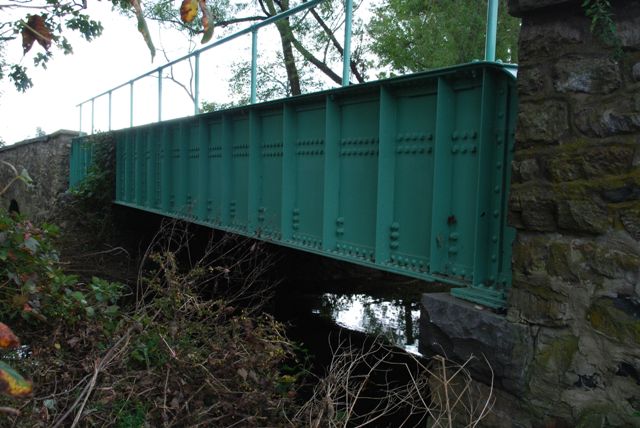We Recommend:
Bach Steel - Experts at historic truss bridge restoration.
Cambridge Road Bridge

Primary Photographer(s): Elaine Deutsch
Bridge Documented: September 30, 2011
Rural: Chester County, Pennsylvania: United States
1910 By Builder/Contractor: York Bridge Company of York, Pennsylvania and Engineer/Design: Nathan R. Rambo
Not Available or Not Applicable
43.0 Feet (13.1 Meters)
55.0 Feet (16.8 Meters)
15.7 Feet (4.79 Meters)
1 Main Span(s) and 2 Approach Span(s)
15401000200000

View Information About HSR Ratings
Bridge Documentation
View Archived National Bridge Inventory Report - Has Additional Details and Evaluation
This bridge is an interesting combination of a plate girder bridge with tiny stone arch culvert approaches. The bridge is also noteworthy because it was rehabilitated (between 2008 and 2011), rather than demolished and replaced as has been the trend in Pennsylvania thus far into the 21st Century. A number of alterations took place during this rehabilitation, however the overall structure retains its original appearance. A number of non-original bolts were added to the sides of the girders. The pole railings appear to have been replaced. Also, the original girder plaque was replaced with a replica. A non-original steel grate deck was replaced with a concrete deck. An earlier rehabilitation took place in 1971 is when the metal grate deck had been installed.
Information and Findings From Pennsylvania's Historic Bridge InventoryDiscussion of Bridge The 3 span, 55'-long bridge built in 1910 consists of an approximately 43'-long steel thru girder span flanked by 6'-long stone arch overflow spans. The bridge is supported on a stone substructure. Fieldstone wingwalls with parapets enclose the approach roadways. Incorporated with the wingwalls are the short stone arch overflow spans. In 1971, the thru girder span was altered by the addition of welded rolled floorbeams spaced between the original riveted rolled floorbeams. At the same time, the previous concrete deck was replaced by an open steel grid deck. Thru girder bridges are a very common bridge type in widespread use from the late 19th century through the mid 20th century. This altered example has no technologically unusual or noteworthy features, and incorporates details, such as the stone arch overflow spans and wingwalls, that are very typical of bridges designed by Chester County Engineer Nathan R. Rambo from 1899 to 1922. The bridge is not significant in the state context, and more complete prototypical examples have been chosen to represent the bridge type's significance in the county context. The bridge is not historically significant in association with its setting. Discussion of Surrounding Area The bridge carries a 2 lane road over a stream in a rural setting of active farms and mixed 19th to late-20th-century residences approximately 1/2 mile east of the crossroads village of Cambridge. The setting does not have the cohesiveness or integrity of a potential historic district, although there are some individual properties with possible individual historic significance including a mid 19th century stone mill building (inoperable) at the bridge's northwest quadrant. The other bridge quadrants are wooded or open fields. Bridge Considered Historic By Survey: No |
![]()
Photo Galleries and Videos: Cambridge Road Bridge
Bridge Photo-Documentation
Original / Full Size PhotosA collection of overview and detail photos. This gallery offers photos in the highest available resolution and file size in a touch-friendly popup viewer.
Alternatively, Browse Without Using Viewer
![]()
Bridge Photo-Documentation
Mobile Optimized PhotosA collection of overview and detail photos. This gallery features data-friendly, fast-loading photos in a touch-friendly popup viewer.
Alternatively, Browse Without Using Viewer
![]()
Maps and Links: Cambridge Road Bridge
Coordinates (Latitude, Longitude):
Search For Additional Bridge Listings:
Bridgehunter.com: View listed bridges within 0.5 miles (0.8 kilometers) of this bridge.
Bridgehunter.com: View listed bridges within 10 miles (16 kilometers) of this bridge.
Additional Maps:
Google Streetview (If Available)
GeoHack (Additional Links and Coordinates)
Apple Maps (Via DuckDuckGo Search)
Apple Maps (Apple devices only)
Android: Open Location In Your Map or GPS App
Flickr Gallery (Find Nearby Photos)
Wikimedia Commons (Find Nearby Photos)
Directions Via Sygic For Android
Directions Via Sygic For iOS and Android Dolphin Browser
USGS National Map (United States Only)
Historical USGS Topo Maps (United States Only)
Historic Aerials (United States Only)
CalTopo Maps (United States Only)

